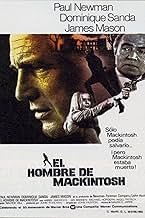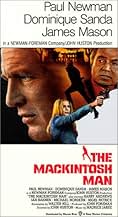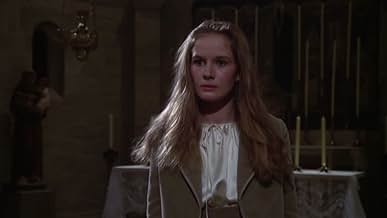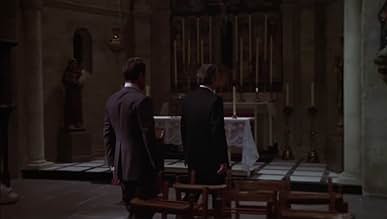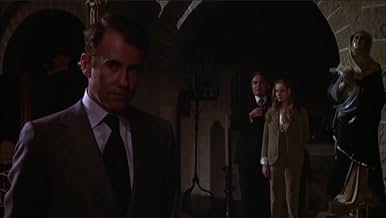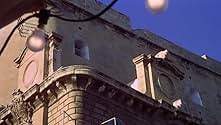Ajouter une intrigue dans votre langueA member of British Intelligence assumes a fictitious criminal identity and allows himself to be caught, imprisoned, and freed in order to infiltrate a spy organization and expose a traitor.A member of British Intelligence assumes a fictitious criminal identity and allows himself to be caught, imprisoned, and freed in order to infiltrate a spy organization and expose a traitor.A member of British Intelligence assumes a fictitious criminal identity and allows himself to be caught, imprisoned, and freed in order to infiltrate a spy organization and expose a traitor.
- Réalisation
- Scénario
- Casting principal
Avis à la une
The movie crosses interestingly several genres, like a cold war spy thriller and prison movies. Some of the scenes manage to catch something familiar from early Hitchcock, specially the runaway and chase scene on an Irish moor. The locations in London and Ireland with real local people add much to the realism and fascination of the story. Even the car chases use old beaten up vehicles keeping far away from usual top agent style.
Paul Newman as Joseph Rearden does a strong role but the cool center of the story is Dominique Sanda as an almost emotionless beauty whose appearance covers secrets and surprises. The plot holds up very well all the way to the final moments with some nasty surprises. A film worth seeing for Huston fans and others.
Another parallel can be seen in the casting. Besides Newman himself, there is Huston's selection of the mysterious Dominique Sanda, one of Europe's most sensuous stars, whose appeal mirrors Hitchcock's obsession with the cool blonde beauty of Grace Kelly, Eva Marie Saint or Tippi Hedren.
Then, too, we have the eloquent James Mason in a late role commanding the opening of the film in the House of Lords by holding forth in the grand manner. But we should guess that he is here a Hitchcockian anti-hero, one in the mold of Phillip Vandamm from Hitch's monumental "North by Northwest." More parallels could be drawn, but for the mise-en-scene, Huston does one up on Hitch by actually filming in Ireland and Malta.
As for the plot it appears to have the tempting multilayered complexity of a typical English thriller, such as those in which Michael Caine appeared before he was swallowed up by Hollywood. If there are plot densities, we are after all, dealing with agents and double-agents, and things can get knotted up. In what other country than England could upperclass spies -- traitors-- be celebrated in literature and movies like the agents Philby or Blunt? Newman's adversaries are gentlemen, but not what they seem to be. We even get an idea of what an English prison is like and the quantities of laundry that they do. Last of all, who is Mrs. Smith? A name deliberately chosen for its opaqueness. Is she convincing as Mackintosh's daughter, or is she merely an agent, and not even a double agent? Yes, there are holes in the plot, but overall, the performances and Newman's Great Escape make up for the plot weaknesses.
Of four ****, three and a half. Still a must for fans of the director Huston, or the stars Newman, Mason or Sanda, and the many supporting stalwarts of British b/w postwar movies and Masterpiece Theatre productions.
Perhaps the problem is that, after years of James Bond movies and various Cold War thrillers, too many of the film's elements have simply been done before and done better, and the ominous feeling of déjà vu is too immense for the film to survive. Or maybe the problem is that we expect a lot more from a director with clout of John Huston, who seems to take a strangely apathetic approach to the material which makes the film's recycled elements feel even more trying. For whatever reason, the film never seems to grip us in the way a good thriller is supposed to. As a whole, THE MACKINTOSH MAN is a fine film for a rainy evening, but it stands as not only a wasted opportunity, but also as possibly the least distinctive film of director Huston.
Le saviez-vous
- AnecdotesIn his autobiography, cinematographer Oswald Morris recalled how John Huston showed very little interest or enthusiasm for directing this movie and would arrive late on-set, largely unprepared for the day's schedule. It often was left to Morris and the crew to fill the gap and set up the shots for the day for when Huston eventually arrived and also to help Paul Newman, who also was disappointed by Huston's attitude.
- GaffesReflected in the side window of the truck when Rearden drives off to meet the airplane at the airfield.
- Citations
Slade: [musing poetically] I'm going home.
[quoting poetry]
Slade: 'Sleep after toil, port after stormy seas, ease after war, death after life does greatly please.'
Joseph Rearden: [laconically] I don't know about you, Slade; I'm not ready for death. The rest I'll drink to.
- Versions alternativesUK theatrical release was cut for violence to secure an AA rating with heavy edits to the beating of Reardon and shots of Gerda being kicked and hit with a gun. All later video and DVD releases are uncut and 15 rated.
- ConnexionsReferenced in Magnum Cop (1978)
Meilleurs choix
- How long is The MacKintosh Man?Alimenté par Alexa
Détails
- Date de sortie
- Pays d’origine
- Langue
- Aussi connu sous le nom de
- El emisario de Mackintosh
- Lieux de tournage
- Kilmainham Jail, Dublin, County Dublin, Irlande(where Reardon is imprisoned)
- Sociétés de production
- Voir plus de crédits d'entreprise sur IMDbPro
Box-office
- Montant brut aux États-Unis et au Canada
- 3 300 000 $US
Contribuer à cette page



